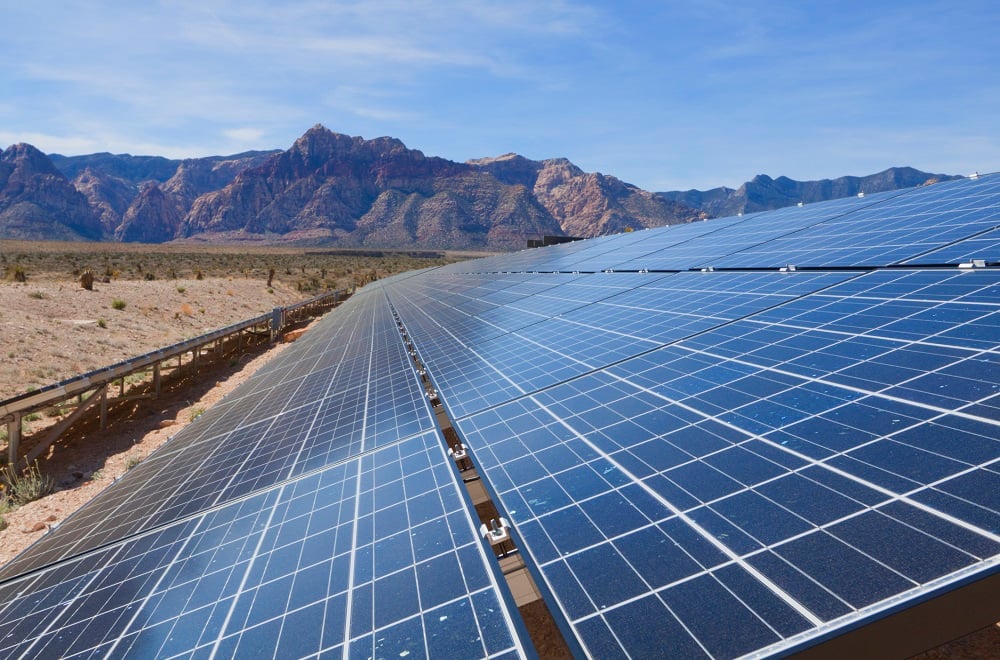On September 10, 2018, California made history with the passage of its most ambitious clean energy goal yet—100% zero-carbon electricity by 2045. Senate Bill 100 (SB-100) also requires that 50% of California's electricity be powered by renewable resources by 2026, and 60% by 2030.
As the world's fifth-largest economy, California is leading the way in the shift to renewable energy. And as the largest generator of renewable energy in the state, the solar power industry will need to rise to the challenge.
Is 100% clean energy by 2045 possible?
While ambitious, at least the first target (50% from renewables by 2026), appears well within reach.
Even before the passage of SB-100, the state's largest utilities were ahead of schedule on the previous goals, with San Diego Gas & Electric slated to hit 45.2% from renewables by 2020, Pacific Gas & Electric 43%, and Southern California Edison 41.4%.
According to the California Energy Commission, renewables accounted for 31.36% of total system electric generation in 2018—second only to natural gas at 34.91%. The Commission estimated that 32% of retail energy sales were powered by renewable sources in 2017.
As to whether 100% clean energy is possible by 2045, there is considerably more debate. What kinds of new technologies will be required? What will need to happen for the energy to not only be clean, but also cost-efficient?
What changes and new technologies might be needed to meet the goal?
SB-100 doesn't lay out a specific roadmap or plan for reaching the 100% clean energy goal. It is intentionally vague. While the first 60% must be from specified renewable resources, the bill doesn't define or restrict what qualifies as "zero carbon" for the remaining 40%.
The hope is that setting an ambitious goal without strict parameters will send a message to investors, energy scientists and tech developers that there's strong demand—thereby spurring new investment and research.
Scientists and industry experts cite the following key areas for development and improvement.
Large-Scale Energy Storage Technologies
Renewable energy generation varies from day to day, hour to hour. Sun and wind energy production slows in the evening as the sun goes down and the winds calm. On the current grid, on-demand gas power is still needed to fill in the gaps.
Part of the solution is high-capacity, more affordable energy storage technologies. The California Energy Storage Alliance estimates that the state will need an additional 9,604 MW of storage capacity to meet its needs. This may take the form of grid-scale battery projects, such as Tesla's "big battery" in Australia.
Large-scale energy storage systems not only address the issue of variable energy resource generation, but can be designed to provide other crucial benefits:
- Frequency control
- Voltage support and grid stabilization
- Decreased transmission losses
- Decreased congestion
- Increased reliability
Grid Modernization
The electrical grid was first built in the 1890s and has been improved and expanded over the years. It's served us well for a long time, but it wasn't built with variable power sources in mind. As these sources begin to supply more and more power to the grid, integrating them will get increasingly difficult.
In order to fully make the switch to clean energy, the grid will need to be modernized...perhaps even rethought entirely.
What might this modernized grid look like? Here are some of the top ideas.
Smart Grid
The Smart Grid, as presented by the U.S. Department of Energy, is meant to make better use of renewable energy resources through increased storage capabilities and new tools that let operators reduce demand quickly when generation dips. A smarter grid would incorporate controls and automation to respond digitally to fluctuating demand. The Smart Grid plan also describes an "electric superhighway" that would "ship" power where it's needed—for example, sending wind power from a state where the wind is blowing to one where it is not.
Smaller Grids & More Efficient Management
The Western grid is a single interconnected system that crosses over 14 U.S. states, two Canadian provinces and part of northern Mexico. Operation and oversight is handled by more than 40 different ISOs, utilities and other organizations. This results in higher costs. Splitting up this massive system into smaller ones (for example, a grid system for one individual state) could make management easier and more efficient, thereby helping to offset the cost of the switch to clean energy.
Regionalization
Some experts see regionalization as crucial to meeting the 100% clean energy goal. Better coordination of grid operators and opening up the wholesale energy market could give California access to more renewables and other zero-carbon resources to supplement its own production. Though California produces far and away the most solar energy, the state may need to "import" energy from wind-rich states like Wyoming in order to meet its goals.
This also opens up the possibility for solar energy exports to other states, opening up new markets for California.
Behind-the-Meter Energy Storage Systems
![]()
SB-100 wasn't the only clean energy bill passed in 2018. California also passed SB-700, or the "Million Solar Roofs of Energy Storage" bill. It extended the state's Self-Generation Incentive Program (SGIP) through 2025, with funding to supply $830 million total in incentives for qualifying behind-the-meter technologies. The California Solar & Storage Association (CALSSA) estimates that 80% of the budget will be dedicated to energy storage, both residential and non-residential. They also estimate behind-the-meter battery deployments in the 2–2.5 GW range through the end of 2025.
Improved behind-the-meter energy storage systems could allow additional homes, commercial and industrial facilities, military bases, university campuses and energy customers to generate their own solar power for primary or supplemental use, with reliable backups.
SB-100's zero-carbon requirement only applies to retail electricity, not self-generation. Still, self-generation indirectly helps the utilities meet the goal by reducing the amount of electricity from renewables they need to provide.
SB-100's Impact on the Solar PV Industry
California leads the nation in solar power generation, producing nearly 37% of the U.S. total. By contrast, the next highest producer is North Carolina with 7.4%. California is also the largest market for battery deployment.
As much solar power as California produces now, that number will only increase in order to meet the new renewable energy benchmarks. PV Magazine estimates that the passage of SB-100 could result in as much as 10 GW of solar and wind energy by 2030. If production trends follow as they have, the bulk of that could likely come from solar.
In order to meet California's demand for clean energy, solar PV plants will need to scale up, integrate new storage technologies, and increase efficiency. Nor-Cal Controls can help.
Scalable Control Systems
Ever-increasing demand for solar power means scaling up to meet that need. Our open architecture SCADA systems are designed to do just that. They are "bolt on compatible," meaning that they scale easily by adding, upgrading or swapping components. We consider the future needs of the SCADA system when providing a turnkey solution. You can read more about those advantages here.
Battery Management Systems
We are getting many more requests from EPCs for our Power Plant Controller (PPC) to interface with the onsite Battery Management Systems (BMS). We are coordinating with BMS manufacturers and integration companies to implement energy storage control requirements into our SCADA systems, and are excited about the developments happening there.
Help Meeting ISO and Utility Requirements
With over 7GW worth of successfully commissioned solar PV projects across the country, our engineers and leadership are well versed in many different ISO and utility requirements.
Not only will we ensure that the site's SCADA system will meet all the requirements, we can help walk owners and operators through the entire process. We offer California ISO (CAISO) support services to prepare solar facilities for commercial operations in California. These services include CAISO NRI, RIG and metering compliance and a CAISO ADS solution.
Automation, Analytics & Efficiency

Our control systems have kept pace with technologies that help solar plants get the most production, including tracking systems and soiling sensors.
One of the biggest hurdles the solar industry must overcome in order to help California meet its clean energy goal is labor costs. Eighty percent of solar operating costs can be attributed to labor. Advanced analytics and automated workflows are key in reducing manual labor costs and allocating resources strategically. We work together with Power Factors to create SCADA asset performance management platforms that improve productivity and reduce operational costs.
If you're interested in working with us for your solar PV project, schedule a call or send a message today. Together, we can help California meet its 100% clean energy goal.


